[English] 日本語
 Yorodumi
Yorodumi- PDB-6wx6: Cryo-EM Structure of Human Apoferritin Light Chain Vitrified Usin... -
+ Open data
Open data
- Basic information
Basic information
| Entry | Database: PDB / ID: 6wx6 | ||||||||||||
|---|---|---|---|---|---|---|---|---|---|---|---|---|---|
| Title | Cryo-EM Structure of Human Apoferritin Light Chain Vitrified Using Back-it-up | ||||||||||||
 Components Components | Ferritin light chain | ||||||||||||
 Keywords Keywords | METAL BINDING PROTEIN / Human / apoferritin / ferritin / light chain / back-it-up / through-grid wicking | ||||||||||||
| Function / homology |  Function and homology information Function and homology informationferritin complex / Scavenging by Class A Receptors / Golgi Associated Vesicle Biogenesis / autolysosome / ferric iron binding / autophagosome / iron ion transport / Iron uptake and transport / ferrous iron binding / azurophil granule lumen ...ferritin complex / Scavenging by Class A Receptors / Golgi Associated Vesicle Biogenesis / autolysosome / ferric iron binding / autophagosome / iron ion transport / Iron uptake and transport / ferrous iron binding / azurophil granule lumen / intracellular iron ion homeostasis / iron ion binding / Neutrophil degranulation / extracellular exosome / extracellular region / identical protein binding / membrane / cytoplasm / cytosol Similarity search - Function | ||||||||||||
| Biological species |  Homo sapiens (human) Homo sapiens (human) | ||||||||||||
| Method | ELECTRON MICROSCOPY / single particle reconstruction / cryo EM / Resolution: 2 Å | ||||||||||||
 Authors Authors | Tan, Y.Z. / Rubinstein, J.L. | ||||||||||||
| Funding support |  Canada, 3items Canada, 3items
| ||||||||||||
 Citation Citation |  Journal: Acta Crystallogr D Struct Biol / Year: 2020 Journal: Acta Crystallogr D Struct Biol / Year: 2020Title: Through-grid wicking enables high-speed cryoEM specimen preparation. Authors: Yong Zi Tan / John L Rubinstein /  Abstract: Blotting times for conventional cryoEM specimen preparation complicate time-resolved studies and lead to some specimens adopting preferred orientations or denaturing at the air-water interface. Here, ...Blotting times for conventional cryoEM specimen preparation complicate time-resolved studies and lead to some specimens adopting preferred orientations or denaturing at the air-water interface. Here, it is shown that solution sprayed onto one side of a holey cryoEM grid can be wicked through the grid by a glass-fiber filter held against the opposite side, often called the `back', of the grid, producing a film suitable for vitrification. This process can be completed in tens of milliseconds. Ultrasonic specimen application and through-grid wicking were combined in a high-speed specimen-preparation device that was named `Back-it-up' or BIU. The high liquid-absorption capacity of the glass fiber compared with self-wicking grids makes the method relatively insensitive to the amount of sample applied. Consequently, through-grid wicking produces large areas of ice that are suitable for cryoEM for both soluble and detergent-solubilized protein complexes. The speed of the device increases the number of views for a specimen that suffers from preferred orientations. | ||||||||||||
| History |
|
- Structure visualization
Structure visualization
| Movie |
 Movie viewer Movie viewer |
|---|---|
| Structure viewer | Molecule:  Molmil Molmil Jmol/JSmol Jmol/JSmol |
- Downloads & links
Downloads & links
- Download
Download
| PDBx/mmCIF format |  6wx6.cif.gz 6wx6.cif.gz | 1.4 MB | Display |  PDBx/mmCIF format PDBx/mmCIF format |
|---|---|---|---|---|
| PDB format |  pdb6wx6.ent.gz pdb6wx6.ent.gz | 1.1 MB | Display |  PDB format PDB format |
| PDBx/mmJSON format |  6wx6.json.gz 6wx6.json.gz | Tree view |  PDBx/mmJSON format PDBx/mmJSON format | |
| Others |  Other downloads Other downloads |
-Validation report
| Arichive directory |  https://data.pdbj.org/pub/pdb/validation_reports/wx/6wx6 https://data.pdbj.org/pub/pdb/validation_reports/wx/6wx6 ftp://data.pdbj.org/pub/pdb/validation_reports/wx/6wx6 ftp://data.pdbj.org/pub/pdb/validation_reports/wx/6wx6 | HTTPS FTP |
|---|
-Related structure data
| Related structure data |  21951MC  6wxbC M: map data used to model this data C: citing same article ( |
|---|---|
| Similar structure data | |
| EM raw data |  EMPIAR-10421 (Title: Single-Particle CryoEM of Human Apoferritin Light Chain Vitrified Using Back-it-up EMPIAR-10421 (Title: Single-Particle CryoEM of Human Apoferritin Light Chain Vitrified Using Back-it-upData size: 2.1 TB Data #1: Unaligned Falcon IV movie frames [micrographs - multiframe] Data #2: Aligned Dose-Weighted Micrographs [micrographs - single frame] Data #3: Final Particle Stack with Final Euler Angles and Shifts [picked particles - multiframe - processed]) |
- Links
Links
- Assembly
Assembly
| Deposited unit | 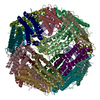
|
|---|---|
| 1 |
|
- Components
Components
| #1: Protein | Mass: 24275.898 Da / Num. of mol.: 24 / Mutation: K173R Source method: isolated from a genetically manipulated source Source: (gene. exp.)  Homo sapiens (human) / Gene: FTL / Production host: Homo sapiens (human) / Gene: FTL / Production host:  Homo sapiens (human) / Strain (production host): HEK293F / References: UniProt: P02792 Homo sapiens (human) / Strain (production host): HEK293F / References: UniProt: P02792#2: Chemical | ChemComp-CA / #3: Water | ChemComp-HOH / | Has ligand of interest | N | |
|---|
-Experimental details
-Experiment
| Experiment | Method: ELECTRON MICROSCOPY |
|---|---|
| EM experiment | Aggregation state: PARTICLE / 3D reconstruction method: single particle reconstruction |
- Sample preparation
Sample preparation
| Component | Name: Human apoferritin light chain / Type: ORGANELLE OR CELLULAR COMPONENT / Entity ID: #1 / Source: RECOMBINANT |
|---|---|
| Molecular weight | Value: 0.58 MDa / Experimental value: NO |
| Source (natural) | Organism:  Homo sapiens (human) Homo sapiens (human) |
| Source (recombinant) | Organism:  Homo sapiens (human) / Strain: HEK293F Homo sapiens (human) / Strain: HEK293F |
| Buffer solution | pH: 8 |
| Specimen | Embedding applied: NO / Shadowing applied: NO / Staining applied: NO / Vitrification applied: YES |
| Specimen support | Details: Both sides of the grid were glow discharged for 120 seconds. Grid material: COPPER/RHODIUM / Grid type: Homemade |
| Vitrification | Instrument: HOMEMADE PLUNGER / Cryogen name: ETHANE-PROPANE / Humidity: 50 % / Chamber temperature: 298 K Details: Back-it-up (ultrasonic specimen application and through-grid wicking in a high-speed specimen preparation device) was used |
- Electron microscopy imaging
Electron microscopy imaging
| Experimental equipment |  Model: Titan Krios / Image courtesy: FEI Company |
|---|---|
| Microscopy | Model: FEI TITAN KRIOS |
| Electron gun | Electron source:  FIELD EMISSION GUN / Accelerating voltage: 300 kV / Illumination mode: FLOOD BEAM FIELD EMISSION GUN / Accelerating voltage: 300 kV / Illumination mode: FLOOD BEAM |
| Electron lens | Mode: BRIGHT FIELD / Cs: 2.7 mm / Alignment procedure: ZEMLIN TABLEAU |
| Specimen holder | Cryogen: NITROGEN / Specimen holder model: FEI TITAN KRIOS AUTOGRID HOLDER |
| Image recording | Average exposure time: 9 sec. / Electron dose: 27 e/Å2 / Film or detector model: FEI FALCON IV (4k x 4k) / Num. of grids imaged: 2 / Num. of real images: 3168 |
| Image scans | Sampling size: 14 µm / Width: 4096 / Height: 4096 |
- Processing
Processing
| EM software |
| ||||||||||||||||||||||||||||||||||||
|---|---|---|---|---|---|---|---|---|---|---|---|---|---|---|---|---|---|---|---|---|---|---|---|---|---|---|---|---|---|---|---|---|---|---|---|---|---|
| CTF correction | Type: PHASE FLIPPING AND AMPLITUDE CORRECTION | ||||||||||||||||||||||||||||||||||||
| Particle selection | Num. of particles selected: 673794 | ||||||||||||||||||||||||||||||||||||
| Symmetry | Point symmetry: O (octahedral) | ||||||||||||||||||||||||||||||||||||
| 3D reconstruction | Resolution: 2 Å / Resolution method: FSC 0.143 CUT-OFF / Num. of particles: 594259 / Symmetry type: POINT | ||||||||||||||||||||||||||||||||||||
| Atomic model building | B value: 14.91 / Protocol: RIGID BODY FIT / Space: REAL | ||||||||||||||||||||||||||||||||||||
| Atomic model building | PDB-ID: 2FFX Accession code: 2FFX / Source name: PDB / Type: experimental model |
 Movie
Movie Controller
Controller



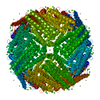


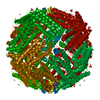
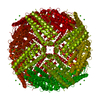
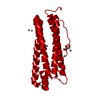



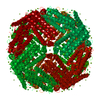
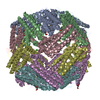
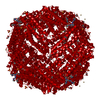
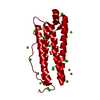

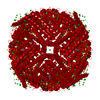



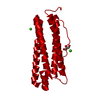

 PDBj
PDBj







